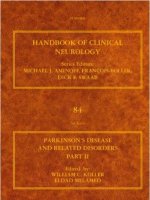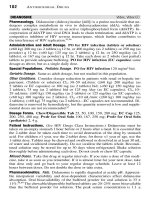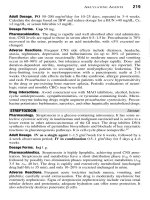Oxford American Handbook of Clinical Diagnosis
Bạn đang xem bản rút gọn của tài liệu. Xem và tải ngay bản đầy đủ của tài liệu tại đây (2.68 MB, 528 trang )
About the Oxford American Handbooks in Medicine
The Oxford American Handbooks are flexi-covered pocket clinical
books, providing practical guidance in quick reference, note form. Titles
cover major medical specialties or cross-specialty topics and are aimed at
students, residents, internists, family physicians, and practicing physicians
within specific disciplines.
Their reputation is built on including the best clinical information, complemented by hints, tips, and advice from the authors. Each one is carefully
reviewed by senior subject experts, residents, and students to ensure that
content reflects the reality of day-to-day medical practice.
Key series features
- Written in short chunks, each topic is covered in a two-page spread to
enable readers to find information quickly. They are also perfect for
test preparation and gaining a quick overview of a subject without
scanning through unnecessary pages.
- Content is evidence based and complemented by the expertise and
judgment of experienced authors.
- The Handbooks provide a humanistic approach to medicine—it’s more
than just treatment by numbers.
- A “friend in your pocket,” the Handbooks offer honest, reliable guidance about the difficulties of practicing medicine and provide coverage
of both the practice and art of medicine.
- For quick reference, useful “everyday” information is included on the
inside covers.
- Made with hard-wearing plastic covers, tough paper, and built-in ribbon
bookmarks, the Handbooks stand up to heavy usage.
This page intentionally left blank
Oxford American Handbook of
Clinical Diagnosis
ii
Published and forthcoming Oxford American Handbooks
Oxford American Handbook of Clinical Medicine
Oxford American Handbook of Anesthesiology
Oxford American Handbook of Clinical Dentistry
Oxford American Handbook of Clinical Diagnosis
Oxford American Handbook of Critical Care
Oxford American Handbook of Emergency Medicine
Oxford American Handbook of Nephrology and Hypertension
Oxford American Handbook of Obstetrics and Gynecology
Oxford American Handbook of Oncology
Oxford American Handbook of Otolaryngology
Oxford American Handbook of Pediatrics
Oxford American Handbook of Psychiatry
Oxford American Handbook of Pulmonary Medicine
Oxford American Handbook of Rheumatology
Oxford American Handbook of Surgery
iii
Oxford American
Handbook of
Clinical
Diagnosis
Gregg Y. Lipschik
Joan M. Von Feldt
Lawrence Frame
Scott Akers
University of Pennsylvania School of Medicine
Philadelphia, Pennsylvania
Salvatore Mangione
Thomas Jefferson School of Medicine
Philadelphia, Pennsylvania
Huw Llewelyn
Kettering General Hospital
Kettering, Northamptonshire
England
iv
Oxford University Press, Inc., publishes works that further
Oxford University’s objective of excellence
in research, scholarship, and education.
Oxford New York
Auckland Cape Town Dar es Salaam Hong Kong Karachi
Kuala Lumpur Madrid Melbourne Mexico City Nairobi
New Delhi Shanghai Taipei Toronto
With offices in
Argentina Austria Brazil Chile Czech Republic France Greece
Guatemala Hungary Italy Japan Poland Portugal Singapore
South Korea Switzerland Thailand Turkey Ukraine Vietnam
Copyright © 2009 by Huw Llewelyn
Published by Oxford University Press, Inc.
198 Madison Avenue, New York, New York 10016
www.oup.com
Oxford is a registered trademark of Oxford University Press
All rights reserved. No part of this publication may be reproduced,
stored in a retrieval system, or transmitted, in any form or by any means,
electronic, mechanical, photocopying, recording, or otherwise,
without the prior permission of Oxford University Press.
Library of Congress Cataloging-in-Publication Data
Oxford American handbook of clinical diagnosis/Gregg Lipschik ... [et al.].
p. ; cm. —(Oxford American handbooks)
Adapted from: Oxford handbook of clinical diagnosis/Huw Llewelyn ... [et al.].
2nd ed. 2008.
Includes bibliographical references and index.
ISBN 978-0-19-536947-2 (flexicover : alk. paper)
1. Diagnosis—Handbooks, manuals, etc. 2. Physical diagnosis—Handbooks,
manuals, etc. 3. Medical history taking—Handbooks, manuals, etc. I. Lipschik,
Gregg, 1954- II. Oxford handbook of clinical diagnosis. III. Title: Handbook of clinical
diagnosis. IV. Series: Oxford American handbooks.
[DNLM: 1. Diagnosis, Differential—Handbooks. 2. Medical History Taking—
Handbooks. 3. Physical Examination—Handbooks. WB 39 O973 2009]
RC71.3.O938 2008
616.07'5—dc22
2008054687
10 9 8 7 6 5 4 3 2 1
Printed in China
on acid-free paper
v
This material is not intended to be, and should not be considered, a
substitute for medical or other professional advice. Treatment for the
conditions described in this material is highly dependent on the individual
circumstances. Although this material is designed to offer accurate information with respect to the subject matter covered and to be current as
of the time it was written, research and knowledge about medical and
health issues are constantly evolving and dose schedules for medications
are being revised continually, with new side effects recognized and
accounted for regularly. Readers must, therefore, always check the product
information and clinical procedures with the most up-to-date published
product information and data sheets provided by the manufacturers and
the most recent codes of conduct and safety regulation. Oxford University Press and the authors make no representations or warranties to
readers, express or implied, about the accuracy or completeness of this
material, including, without limitation, that they make no representation
or warranties about the accuracy or efficacy of the drug dosages mentioned in the material. The authors and the publishers do not accept, and
expressly disclaim, any responsibility for any liability, loss, or risk that may
be claimed or incurred as a consequence of the use and/or application of
any of the contents of this material.
vi
For Angela
and
for Debra
vii
Preface
This book explains how to use a history, examination, and preliminary
tests to arrive at a diagnosis. This helps us as clinicians to anticipate what
may happen next and how interventions may influence the disease process.
We are also better equipped to share with our patients and colleagues
what we are thinking and doing.
The approach used here enables clinicians to focus on symptoms,
physical signs, and initial test results that are likely to lead to a diagnosis.
This is based on the principle that diagnostic leads with short differential
diagnoses will be more informative than those features with long lists of
causes.
Each sign or symptom on a page is followed by a list of diagnoses with
associated suggestive and confirmatory clinical and laboratory features.
The reader may scan down the page to see which entries are compatible
with the patient’s findings thus far. The compatible findings can then be
used as evidence for the diagnosis.
In the spirit of the Oxford American Handbooks, readers are encouraged to be critical about the contents of the book, to make changes, and
to let us know of any significant differences in opinion or errors.
GL & HL
viii
Acknowledgments
This book is based on ideas and teaching methods developed originally
by Dr. Huw Llewelyn at King’s College Hospital, London. Dr. Llewelyn also
designed and wrote this book with the assistance of his colleagues
Drs. Hock Ang, Anees Al-Abdullah, and Keir Lewis. It was edited for the
U.S. market by Drs. Gregg Lipschik, Joan Von Feldt, Lawrence Frame,
Salvatore Mangione, and Scott Akers.
ix
Contents
Some important questions and answers about
this book xi
Symbols and abbreviations xxi
1
2
3
4
5
6
7
8
9
10
11
12
13
14
15
16
17
18
19
The diagnostic process
Transparent diagnosis
History-taking skills and imagination
Physical examination skills and leads
General examination physical signs
Cardiovascular symptoms
Cardiovascular signs
Respiratory symptoms
Respiratory signs
GI symptoms
GI signs
Neurological symptoms
Neurological signs
GU symptoms
GU signs
Musculoskeletal symptoms and signs
Psychiatric symptoms and signs
Laboratory tests
Chest X-ray appearances
Index 475
1
15
35
53
71
127
145
175
187
209
249
285
301
357
367
383
409
417
437
This page intentionally left blank
xi
Some important
questions and answers
about this book
1.
2.
3.
4.
5.
6.
7.
8.
9.
10.
11.
12.
13.
14.
How is this book different from other textbooks? p. xi
Does this book claim to reveal all the mysteries of diagnosis? p. xii
What approach to diagnosis does this book describe? p. xiii
Is there a simple concept on which transparent diagnosis is based? p. xiiii
What are “leads,” and how are they used? p. xiv
At what point in a medical career is this book useful? p. xiv
In what situations can this book be used? p. xv
How does the structure of the book work? p. xv
How can the book be used as a learning tool? p. xvi
Can a transparent approach improve the diagnostic accuracy of an
experienced physician? p. xvi
How does this approach relate to diagnostic algorithms? p. xvi
How comprehensive is the information about each diagnosis? p. xvii
What is meant by facts, opinions, and evidence in the book? p. xvii
How do the concepts in the book relate to statistical and other
models of diagnosis? p. xviii
1. How is this book different from
other textbooks?
Most medical books describe a disease process and give physiological,
biochemical, and other explanations for the causes and complications and
how these processes can be treated. They also describe what symptoms,
signs, and test results occur. When a patient presents with new symptoms and other findings, readers must somehow work out which, of all
the conditions they have read about, the patient has.
This book is different. It lists the causes of findings that are the best
clues (or “leads”) and then outlines some findings, which, when used in
combination with the lead, suggest the diagnosis with a reasonably high
probability, or confirm it.
The number of findings is usually small, for two reasons. The first is
that many findings occur often in many other diseases and are therefore
nonspecific; it is only a few that form powerful predictors. The second
reason is practical—it is only possible to build up experience of small
combinations of findings because it is difficult to find many patients with
the same large combination of findings.
xii
IMPORTANT QUESTIONS AND ANSWERS
Important
questions
and answers
Important questions
and answers
The diagnostic findings given in this book are based mostly on an impression of what other doctors expect in the form of evidence for a diagnosis during clinical discussions (or in an evidence-based past medical
history). Ideally, these findings should have been shown to form the best
combinations that identify patients who respond well to treatment compared to placebo in clinical trials. Failing this, they should be the combinations recognized by convention as being the best (known as “diagnostic
criteria”). In the absence of both these situations, one has to resort to
impressions of what most physicians would think reasonable.
The usefulness of suggestive findings would also require more studies on
their frequency of occurrence in association with different diagnostic criteria
in various clinical settings.
2. Does this book claim to reveal all
the mysteries of diagnosis?
No—the way in which our minds work is a mystery, as is much of the
diagnostic process. Diagnosis is based on the Greek “to know through.”
In the context of medicine, it is to see through the patient’s symptoms
and other findings to imagine and understand what may be happening in
terms of current theories applied to medicine. The decision of what to
do is made by using the diagnosis to infer what will probably happen next
and how the process can be changed by various available interventions.
Physicians learn to do this by experience, so that as they take a history
and examine a patient, it “dawns” on them what may be going on, what
may happen next, and what they should do. In essence, their diagnosis is
a title or label for what they are imagining in terms of current processes
and future events.
The process is uncertain. Philosophically, we can only show that other
diagnoses or hypotheses are improbable and that the patient’s findings
are probably explained by only one known diagnosis. However, there
may be some other processes not yet discovered by basic medical
research, with which the patient’s findings are also compatible. Therefore, the outcomes of actions based on a presumed diagnosis have to be
monitored and the diagnosis and decision revised, if necessary. The process is often cyclical, so that the physician is supplementing the patient’s
own reparative and homeostatic feedback processes.
The diagnostician has to be alert to new concerns, symptoms, and
other findings and must be able to interpret them to arrive at new diagnoses and decisions. Surgeons may have to do this as they are operating
on a patient; what may appear to be a simple, routine procedure may
produce surprises and require a quick, innovative, and skilled response.
Diagnosis is thus bound up with clinical management. Physicians depend
on such rapid intuitive processes to get through their day with the speed
and efficiency required of them.
In some cases a doctor will listen to the patient, conduct an examination, and decide what to do (e.g., giving a pain-relieving drug, pressing on
a bleeding wound, or sending the patient quickly to the hospital) without
IMPORTANT QUESTIONS AND ANSWERS
consciously thinking of a diagnosis. It is only on reflection that he or she
will offer an explanation and describe what was imagined subconsciously
at the time the decision was made. This is often described as “empirical”
medicine.
3. What approach to diagnosis does
this book describe?
In addition to our private inner thoughts and diagnoses, we have to use
transparent thought processes to explain to others what we are doing.
This is how we explain to patients what we think is wrong and what
should be done. It is also central to teamwork involving members of
other disciplines who have to help to provide the medical care arising
from the various diagnoses that apply to a patient. It is also essential
when handing over care to other teams, which is an increasingly prominent
feature of modern medicine.
So, however mysteriously the mind works, the decisions, diagnoses, and
evidence must also be communicated very clearly to doctors, nurses, and
others in the team, the patients, and their supporters. The diagnosis may
also have to be coded for clinical audit, activity analysis, and payment. The
evidence and reasoning must be communicated in order that others can
understand and, if necessary, continue the thought processes. This is the
public, explicit form of diagnosis and decision making, in contrast to the
private, rapid, intuitive process that often leads to diagnoses and decisions
in the first place.
The explicit diagnostic thought process can also be used to arrive at the
diagnosis in the first place. This has to be done very often by those with
little experience but not infrequently by those with wide experience when
they inevitably meet new situations. This book describes how this is done.
4. Is there is a simple concept on which
transparent diagnosis is based?
Yes—it based on the idea of small, predictive combinations of information. If a group of patients with a combination of features turns out to
have some diagnosis with a known frequency, then if more features are
added, the frequency of the outcome in the new combination will
increase, decrease, or remain the same. However, the original frequency
will represent the average of the new frequencies in the groups formed
by subdividing the original group. Thus, a small combination of features
that predicts an outcome with a very high frequency can be very useful.
This book outlines findings that form useful combinations for diagnosis
and thus predict the outcome of treatment. It does not specify the
detailed, logical structure of the combinations. Before this can be done, it
would be necessary to conduct systematic studies during day-to-day care
at the same time as data are collected for analysis.
xiii
xiv
IMPORTANT QUESTIONS AND ANSWERS
Thus, all of the total evidence of positive and negative findings is taken
into account, but central evidence is identified within it, which is used
to summarize the total evidence.1 If different combinations of central
evidence point to different diagnoses, then these may be simultaneous or
differential diagnoses.
5. What are “leads,” and how are
they used?
A lead is a finding associated with a limited number of conditions and
that is thus easier to investigate. The titles of the pages of this book
represent such leads. An unusual or disturbing symptom or physical sign
may well be a good lead. In the same way, extreme results of measurement are often good leads.
If the reader discovers a good lead when taking the history or examining the patient, then in turning to the appropriate page, he or she will be
able to scan down the page to see if the patient has other features that
form a combination that point to one of the diagnoses.
If the patient’s findings are compatible with a number of different
predictive combinations, then these will represent the differential diagnoses
(provided that they are also capable of causing the presenting complaint).
The approach of assembling a combination of findings by selecting items
of information that occur commonly in one cause, but rarely in others
rarely, is the probabilistic version of logic by elimination.1,2,3 Leads have
also been referred to as “pivots.”4
6. At what point in a medical career is
this book useful?
This book, along with its approach, can be used throughout a medical
career. It can be used by students beginning their medical studies, to
learn the principles of interpreting clinical information. It can be referred
to at any time during clinical clerkships, internship, or residency, when
assessing patients or when tackling diagnostic exercises on paper.
This handbook is also designed to help physicians deal with problems
clearly by using a logical and flexible approach when they are on strange
territory. More importantly, it helps students and doctors to defend
1. Llewelyn DEH (1975). A concept of diagnosis: a relationship between logic and limits of
probability. Clin Sci Mol Med 49;7.
2. Llewelyn DEH (1979). Mathematical analysis of the diagnostic relevance of clinical findings.
Clin Sci 57(5);477–479.
3. Llewelyn DEH (1981). Applying the principle of logical elimination to probabilistic diagnosis.
Med Informatics 6(1);25.
4. Eddy DM, Clanton CH (1982). The art of diagnosis: solving the clinicopathological conference.
Engl J Med 306;1263–1268.
IMPORTANT QUESTIONS AND ANSWERS
their diagnoses and decisions, and if necessary, to help them to explain
their reasoning to patients, nurses, and other doctors verbally or in
evidence-based past medical histories.
A traditional past medical history that summarizes diagnostic evidence
for others would be very helpful when handing over a patient’s care to
another team, especially when transferring a patient between specialties
with mutually unfamiliar conventions of diagnostic evidence. Such an
approach would also reduce unnecessary duplication and wasting of
resources, and might be used on computer systems for health care.
7. In what situations can this book
be used?
The book can be used in a number of situations. It can be read after
taking a history, examining a patient, and arriving at diagnoses and a
management plan. The latter will include a positive finding summary or
problem list, proposed investigations, and initial treatments. The positive
findings can then be looked up in this book, beginning with those most
striking or severe, to see if you have considered important causes and
ways of confirming them.
This book can be used for problem-based learning. Thus, after trying to
solve a problem without the aid of this book, use it for a second attempt.
Make your own notes on the blank pages if you find that a cause or
important finding has not been mentioned. As with other Oxford Handbooks, we would welcome suggestions. Some diseases are only common
in examinations (partly because they provide physical signs that are reliably stable over many years). They are often rare in clinical practice
except in specialized departments.
8. How does the structure of the book
work?
The main part of the book describes the findings that can emerge at each
step of the history and examination and as a result of doing the preliminary tests. Each page will describe the list of the main differential diagnoses to be considered for a lead that is starting point for the diagnostic
reasoning process. Alongside each diagnosis there is an outline of the
typical evidence that suggests the diagnosis with sufficient probability to
justify doing confirmatory tests. It may then outline the typical results of
doing these tests to provide reasonable evidence to confirm the diagnosis. There will be some duplication in that these details will be repeated
for the reader’s convenience each time the diagnosis is listed as a cause
of a symptom or sign.
xv
xvi
IMPORTANT QUESTIONS AND ANSWERS
9. How can the book be used as a
learning tool?
When you read the book, imagine that you have come across a patient
with the finding(s) forming the title for that page. Cover the differential
diagnoses on the left-hand side of the page with your hand or a bookmark to see if you can predict the diagnosis from reading the findings on
the right-hand side of the page. This is the direction in which your mind
should be working when trying to think about diagnosis and solve diagnostic dilemmas. You can then read the whole page for an overview. You
should always try to recall what you know already about something
before reading about it, in order to learn in an integrated way.
10. Can a transparent diagnostic
approach improve the diagnostic
accuracy of an experienced
physician?
It is a common experience that if we try to give a carefully reasoned
justification for an intuitive opinion, especially by writing it down, we
may find that we cannot justify it easily and will reconsider our opinion.
Conversely, if our explicitly reasoned justification confirms our intuitive
opinion, then we will feel more confident in its success.
This is illustrated by what happened when data assembled by the late
Professor Tim de Dombal were analyzed. The surgeon was correct in his
intuitive diagnosis 235/300 = 78.3% of the time, and a transparent, logical
approach using small combinations of findings was correct 230/300 = 76.6%
of the time. However, the surgeon and transparent, logical approach agreed
about the diagnosis in 221/300 of cases. When there was agreement in these
221 instances, the diagnosis was correct in 200/221 = 90.5% of cases.1
11. How does this approach relate to
diagnostic algorithms?
The suggestive and confirmatory evidence under each diagnosis represents
the findings that would have been chosen by following the path down a
diagnostic algorithm in order to arrive at the diagnosis. However, instead
of locking the reader into a fixed sequence, this book allows the reader
to scan the different diagnoses and recognize which findings on the page
best fit those of the patient.
In a sense, each page provides a form of pattern-recognition table. The
confirmatory evidence should be compatible with only one diagnosis.
1. Llewelyn, DEH, (1988). Assessing the validity of diagnostic tests and clinical decisions. MD
thesis. University of London.
IMPORTANT QUESTIONS AND ANSWERS
12. How comprehensive is the
information about each diagnosis?
There is not enough space in a handbook of this kind to describe all the
combinations of evidence that might point to a diagnosis. Therefore, each
page describes some of the differential diagnoses and, for each of these,
an outline of typical findings that are suggestive and confirmatory. This
provides a start to which further information can be added by the reader
in the Oxford Handbook spirit.
The diagnostic causes of a lead are usually listed in the order of their frequency in those patients with the lead. (Sometimes they are grouped together because of causal similarity, e.g., into cardiac causes and not in an
order of frequency.) A major factor in determining this order is the prevalence of those with the diagnosis in the overall study population. Therefore,
the order of the diagnoses on the page may vary between clinical settings.
Readers should try to insert the order number of the diagnostic causes in
terms of probability in their own clinical settings.
13. What is meant by facts, opinions,
and evidence in the book?
Evidence is an account of real events that supports what we believe. It is
made up of facts. Thus, facts are also accounts of real events. Real events
are transient and immediately become memories that are easily forgotten
or distorted. Evidence is usually shared with others, thus it must be
recorded carefully using conventions that other people will also accept.
One of these conventions is that the record of a fact must bear a time
and date so it can be corroborated (e.g., by questioning other witnesses).
If such details are omitted, this may arouse suspicion, even if there is no
need to seek corroboration. In many cases a listener would judge the
probability of corroboration or of replicating the finding to be high.
Most evidence takes the form of contemporaneous notes or printed
numerical values from a measuring device. In other cases, a finding is preserved, e.g., an X-ray, a photograph, or a video recording with sound.
However, all these methods are subject to error or some other distortion,
and the method of detection and recording has to follow appropriate
conventions if they are to be accepted by others.
In this book, evidence is described as being “suggestive” or “confirmatory”
of a diagnosis and when it is applied to a real patient, will have to bear a
date or time. Evidence about a single patient may be termed “particular
evidence,” whereas evidence about a group of patients may be termed
“general evidence.”
The principle of replication also applies to general evidence. For example,
1/77 (1.3%) of normotensive diabetic patients taking placebo with an
albumin excretion rate (AER) starting between 20 and 40 μg/minute had
nephropathy within 2 years.1 This would be general scientific evidence.
xvii
xviii
IMPORTANT QUESTIONS AND ANSWERS
If we took the pile of 77 records from the study, we could simulate
repeat studies by selecting a set of notes at random from the pile, examining it, returning it, and doing this 77 times. If a large number of such
simulated studies were done, then from the binomial distribution there
would be a 99.7% chance of finding nephropathy in 0/77 or 1/77 or 2/77
or 3/77 or 4/77 of patients with a controlled BP in different simulated
studies (i.e., from 0% [0/77] to 5.2% [4/77]). There is thus a 99.7% chance
of replicating the finding of 1/77 by a repeat result being between 0/77
and 4/77 inclusive.
By comparison, the standard 95% confidence interval for 1/77 is 0.03%
to 7.02% and the 99% confidence interval for 1/77 is 0.01% to 9.37%.
However, the probability of replication between two limits is more similar to the percentage confidence interval if the numbers in the study are
high and the observed result is near to 50%.
A fact is an account of an observation, but an opinion is a prediction
about something that has not yet (or even cannot) be seen. If an opinion
can be checked by observation, it can be founded on evidence (it is
substantiable). If it can never be observed, it cannot be founded on evidence (it is unsubstantiable). An opinion can thus be substantiated if it
can be based on past evidence.
For example, if an individual patient’s AER is between 20 and 40
μg/minute, then an opinion that such a diabetic patient with a controlled
BP is unlikely to develop nephropathy would be well founded or substantiated by the fact that of 77 such past patients, only 1 went on to get
nephropathy in a particular study.
14. How do these ideas relate to
statistical and other models of
diagnosis?
Statistical and other mathematical methods (many based on Bayes theorem)
generate a value much like a diagnostic test. These may be calculated
estimates of some biological value, e.g., a calculated glomerular filtration
rate, a diagnostic score, or an estimated probability. All these numerical
outputs of a calculation can be treated in the same way as direct measurements by calibrating them against the frequency of some outcome
(e.g., the proportion who progress to requiring dialysis within 2 years—
see Fig. 2.3). The numerical outputs could then be incorporated into the
suggestive or confirmatory evidence for the diagnosis.
1. Llewelyn DEH, Garcia-Puig J (2004). How different urinary albumin excretion rates can predict
progression to nephropathy and the effect of treatment in hypertensive diabetics. J Renin Angiotensin Aldosterone Syst 5;141–145.
IMPORTANT QUESTIONS AND ANSWERS
Decision analysis1,2 is essentially a process that estimates the result of a
detailed therapeutic clinical trial on a hypothetical group of patients in a
transparent way when a real detailed trial is not available or impracticable. The analysis is usually applied to an individual patient who thus is
identical to all those in the hypothetical group. The approach uses available
estimates of outcome frequencies in the medical literature from related
studies and also estimates from the patient of the range of personal
well-being that should be gained from each outcome.
The analysis involves calculating the average degree of well-being for
each treatment outcome in a transparent way. Doctors may do this for
an individual patient by estimating the outcome of such a hypothetical
trial without making calculations. This approach is not covered in this book.
Detailed contents
1. Dowie J, Elstein A (1988). Professional judgement. A reader in clinical decision making.
Cambridge, UK: Cambridge University Press.
2. Llewelyn H, Hopkins A (1993). Analysing how we reach clinical decisions. London: Royal College
of Physicians of London.
xix
This page intentionally left blank
xxi
Symbols and abbreviations
±
l
i
d
°
>
<
5-HIAA
Ab
ABG(s)
ACE
ACTH
ADH
AER
AFB
ALS
ALT
AML
ANA
ANCA
A-P
ARDS
AS
ASOT
AST
AV
AXR
B-hCG
BM
BMI
BP
bpm
BUN
cANCA
CAPD
CBC
CC
CFS
CHF
with/without
imply
increased
decreased
degrees
greater than
less than
5-hydroxyindole acetic acid
antibody
arterial blood gas(es)
angiotensin-converting enzyme
adrenocorticotrophic hormone
antidiuretic hormone
albumin excretion rate
acid-fast bacillus
amyotrophic lateral sclerosis
alanine transaminase
acute myeloid leukemia
anti-nuclear antibody
anti-neutrophil cytoplasmic antibody
anterior to posterior
acute respiratory distress syndrome
aortic stenosis
anti-streptolysin O titer
asparate transaminase
atrioventricular
abdominal X-ray
B-human chorionic gonadotrophin
bone marrow
body mass index
blood pressure
beats per minute
blood urea nitrogen
cytoplasmic anti-neutrophil cytoplasmic antibody
continuous ambulatory peritoneal dialysis
complete blood count
chief complaint
chronic fatigue syndrome
congestive heart failure
xxii
SYMBOLS AND ABBREVIATIONS
CIN
CK-MB
CLL
CML
CNS
COPD
CPK
CRF
CRP
CSF
CT
CTPA
CV
CVA
CVP
CVS
CXR
DC
D-dimer
DH
DIC
DIP
dL
DLCO
DM
DOB
DVT
ECG (EKG)
ECT
EEG
EF
EGD
ELISA
EMG
ENT
ERCP
ESR
FDP(s)
FEV1
FH
FiO2
Fl
FSH
FT3
FT4
cervical intraepithelial neoplasia
creatine kinase MB isoenzyme
chronic lymphocytic leukemia
chronic myeloid leukemia
central nervous system
chronic obstructive pulmonary disease
creatine phosphokinase
chronic renal failure
C-reactive protein
cerebrospinal fluid
computerized tomography
computerized tomographic pulmonary angiogram
cardiovascular
cerebrovascular accident; costovertebral angle
central venous pressure
cardiovascular system
chest X-ray
direct current
dextrorotatory dimer
drug history
disseminated intravascular coagulation
distal interphalangeal (joint)
deciliter
carbon monoxide diffusing capacity
diabetes mellitus
date of birth
deep vein thrombosis
electrocardiogram
electroconvulsive therapy
electroencephalogram
ejection fraction
esophagogastroduodenoscopy
enzyme-linked immunosorbent assay
electromyography
ear, nose, throat
endoscopic retrograde cholangiopancreatography
erythrocyte sedimentation rate
fibrogen degredation product/s
forced expiratory volume (1 second)
family history
fraction of inspiried oxygen
fluorescein
follicular stimulating hormone
free T3
free T4









